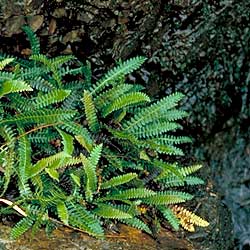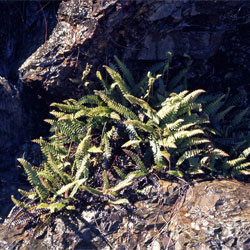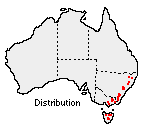Blechnum pennamarina subsp. alpina
 |
 |
Previously often written as Blechnum penna-marina with a hyphen
Alpine Water Fern
Blechnum pennamarina subsp. alpina (R.Br.) T.C.Chambers & P.A.Farrant
This small, hardy fern is commonly called the Alpine Water Fern, and belongs to the family Blechnaceae. The species Blechnum penna-marina is widely distributed across cooler latitudes in the Southern Hemisphere, with only the subspecies alpina occurring in Australia.
 The
Alpine Water Fern occurs naturally in New South Wales south from Mount Kaputar
and Washpool National Parks through to Victoria and Tasmania. It is found mainly
at high altitudes, but will grow at lower altitudes under suitable conditions. Blechnum penna-marina also occurs on many sub-Antarctic islands, including
Macquarie Island, as well as in New Zealand and South America.
The
Alpine Water Fern occurs naturally in New South Wales south from Mount Kaputar
and Washpool National Parks through to Victoria and Tasmania. It is found mainly
at high altitudes, but will grow at lower altitudes under suitable conditions. Blechnum penna-marina also occurs on many sub-Antarctic islands, including
Macquarie Island, as well as in New Zealand and South America.
Blechnum penna-marina is a low-growing compact groundcover fern, reaching from 5-25 cm in height, depending on conditions. Fronds are crowded, appearing either prostrate or erect, from tough, long-creeping, and branched rhizomes. They appear leathery and dark green in colour, being paler on the underside, with stipes or leaf stalks being red-brown. Fronds are pinnatifid to pinnate (once divided) in shape, and dimorphic, with sterile fronds being narrowly linear and fertile fronds being erect, slightly longer and narrower than the sterile fronds.
The natural habitat of this fern is grasslands, stream banks, rock crevices and Sphagnum bogs. It likes moist, well-drained soil, in a protected spot. However, it is quite hardy and can be grown in a wide variety of situations. Best results are achieved if soil is slightly acidic and contains plenty of decomposed organic matter. Although it can tolerate dryness, it is responsive to regular watering and benefits from regular application of a liquid fertiliser.
Specimens growing in the Australian National Botanic Gardens are fertilised fortnightly and appear to be thriving with the attention. Alternatively, slow-release fertilisers and organic fertilisers such as aged blood and bone, seaweed extract and fish emulsion can be used. This fern will grow in part shade to full sun, particularly if kept cool and moist. It appears to benefit from an environment with other plants or rocks around, but being a ground cover fern it also needs room to spread. If growing in the tropics it requires a cool fern house and will only produce fertile fronds in cool climates.
It makes a wonderful rockery fern and is suitable and attractive for growing beside water features. It is also an excellent ground cover and can be used to suppress weeds. It also makes an ideal pot plant.
Blechnum penna-marina is easy to establish and can be readily propagated by division of rhizomes. This is best done in spring or autumn. With patience, it may also be propagated from spores. Most growth occurs in spring and summer, with new pink fronds appearing in springtime. The new growth is attractive not only for its colour, but also for the uncoiling of young fronds (called croziers or fiddleheads). Plants are dormant over winter and begin to grow again in October-November. They should be cut back and tidied-up after they have died down. Plants are frost tolerant and do not seem to experience any major pests or diseases.
This wonderfully hardy and adaptable fern is suitable for many situations, is easy to grow, and can provide an attractive touch of greenery for most gardens.
Text by Leah Seed (2002 Student Botanical Intern)
Name meaning: Blechnum pennamarina subsp. alpinaBlechnum - from the Greek, blechnon, for 'fern'; pennamarina - Latin, penna meaning 'feather', marina meaning growing in the 'sea'; alpina - Latin, referring to its alpine habitat. |
References:
Chaffey, C.H. 1999. Australian Ferns: Growing them successfully. Kangaroo Press, Sydney.
Elliot, W.R. & Jones, D.L. 1982. Encyclopaedia of Australian Plants Suitable for Cultivation, vol. 2. Lothian Publishing Company, Melbourne.
Spencer, R. 1995. Horticultural Flora of South-Eastern Australia, vol. 1, Ferns, Conifers & their Allies. Royal Botanic Gardens, Melbourne, UNSW Press.
![An Australian Government Initiative [logo]](/images/austgovt_brown_90px.gif)

